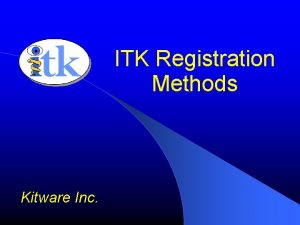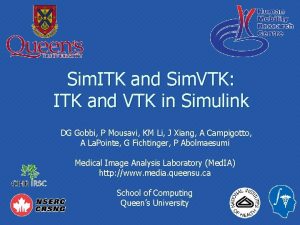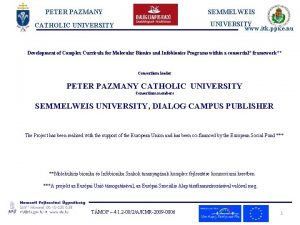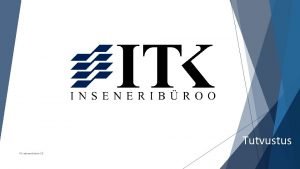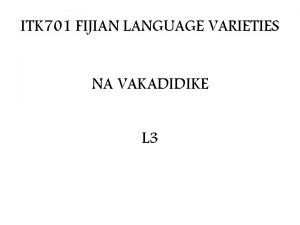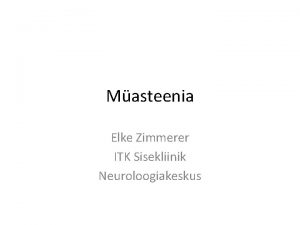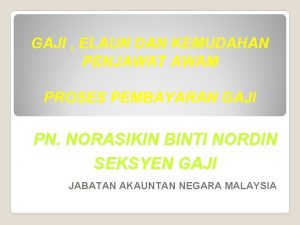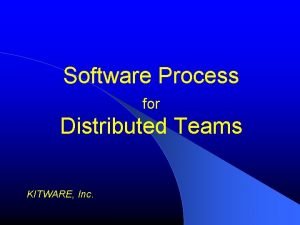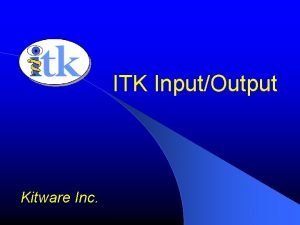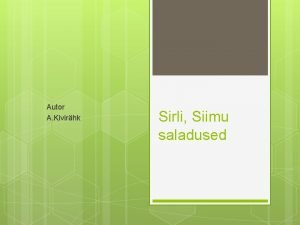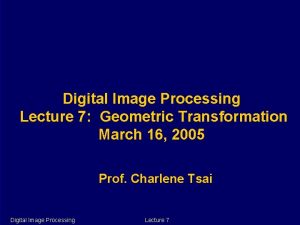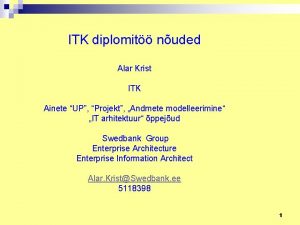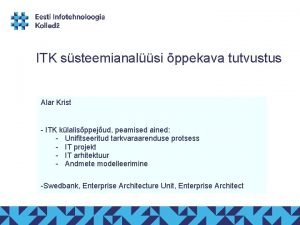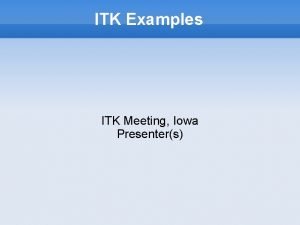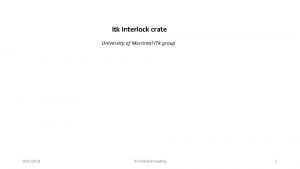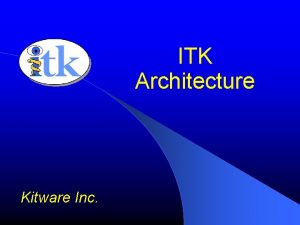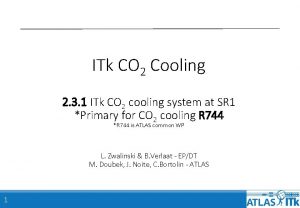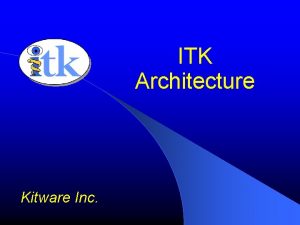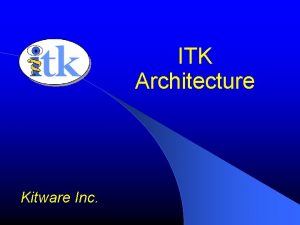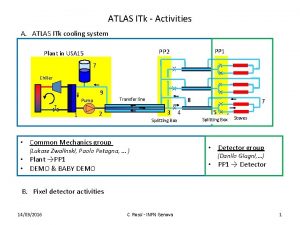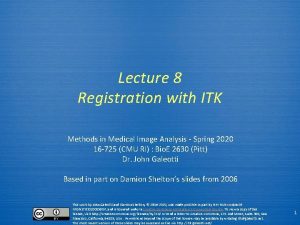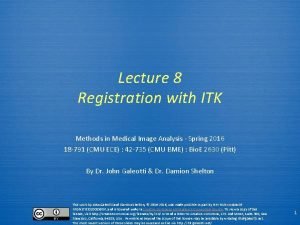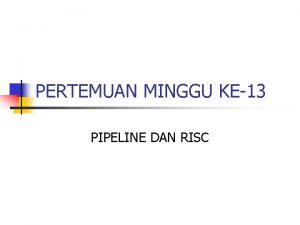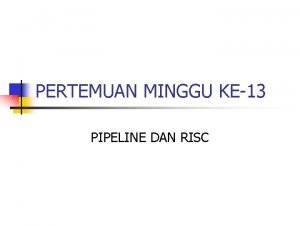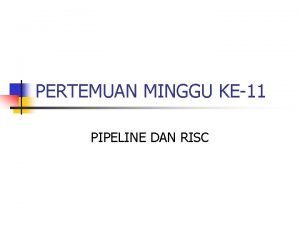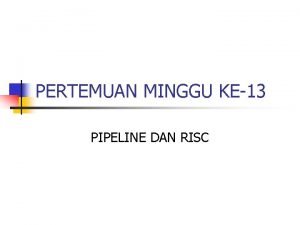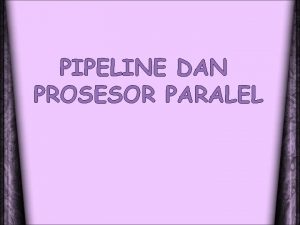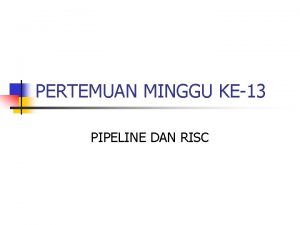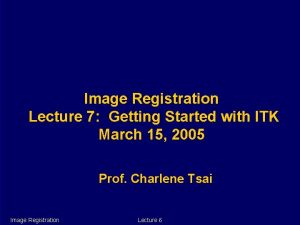Lecture 16 ITK Pipeline Methods in Medical Image


































- Slides: 34

Lecture 16 ITK Pipeline Methods in Medical Image Analysis - Spring 2012 Bio. E 2630 (Pitt) : 16 -725 (CMU RI) 18 -791 (CMU ECE) : 42 -735 (CMU BME) Dr. John Galeotti Based on Shelton’s slides from 2006 This work by John Galeotti and Damion Shelton was made possible in part by NIH NLM contract# HHSN 276201000580 P, and is licensed under a Creative Commons Attribution 3. 0 Unported License. To view a copy of this license, visit http: //creativecommons. org/licenses/by/3. 0/ or send a letter to Creative Commons, 171 2 nd Street, Suite 300, San Francisco, California, 94105, USA. Permissions beyond the scope of this license may be available by emailing itk@galeotti. net. 1

The Pipeline § ITK is organized around data objects and process objects § You should now be somewhat familiar with the primary data object, itk: : Image § Today we’ll talk about how to do cool things to images, using process objects § A pipeline is a series of process objects that operate on one or more data objects § The data objects “flow” along the pipeline 2

The pipeline idea Start here Source Image Filter. A Image Filter. B Image End here The pipeline consists of: § Data objects § Process object (things that create data objects) 3

Image sources Start here Source Image Filter. A Image Filter. B Image End here itk: : Image. Source<TOutput. Image> The base class for all process objects that produce images without an input image 4

Image to image filters Start here Source Image Filter. A Image Filter. B Image End here itk: : Image. To. Image. Filter<TInput. Image, TOutput. Image> The base class for all process objects that produce images when provided with an image as input. 5

Input and output § Image. Source’s do not require input, so they have only a Get. Output() function § Image. To. Image. Filter’s have both Set. Input() and Get. Output() functions 6

Ignoring intermediate images Start here Source Image Filter. A Image Filter. B Image End here = Source Start here Filter Image End here 7

How this looks in code Src. Type: : Pointer src = Src. Type: : New(); Fil. AType: : Pointer filter. A = Fil. AType: : New(); Fil. BType: : Pointer filter. B = Fil. BType: : New(); src->Setup. The. Source(); filter. A->Set. Input( src->Get. Output() ); filter. B->Set. Input( filter. A->Get. Output() ); Image. Type: : Pointer im = filter. B->Get. Output(); 8

When execution occurs § The previous page of code only sets up the pipeline - i. e. , what connects to what § This does not cause the pipeline to execute § In order to “run” the pipeline, you must call Update() on the last filter in the pipeline 9

Propagation of Update() § When Update() is called on a filter, the update propagates back “up” the pipeline until it reaches a process object that does not need to be updated, or the start of the pipeline 10

When are process objects updated? § If the input to the process object has changed § If the process object itself has been modified e. g. , I change the radius of a Gaussian blur filter How does it know? 11

Detecting process object modification § The easy way (when writing your own proces object) is to use itk. Set. Macro(Member. Name, type); which produces the function void Set. Member. Name(type); that calls Modified() for you when a new value is set in the class. § For example, the compiler turns this line of code: itk. Set. Macro(Distance. Min, double); into a member function, Set. Distance. Min(), that sets member variable m_Distance. Min. 12

Process object modification, cont. § The other way is to call Modified() from within a process object function when you know something has changed this->Modified(); § You can call Modified() from outside the class as well, to force an update § Using the macros is a better idea though. . . 13

Running the pipeline – Step 1 Modified? Source Update() Modified? Filter Start here Not sure Image End here Updated Modified 14

Running the pipeline – Step 2 Source Filter Start here Not sure Image End here Updated Modified 15

Running the pipeline – Step 3 Source Filter Start here Not sure Image End here Updated Modified 16

Running the pipeline – Step 4 Source Filter Start here Not sure Image End here Updated Modified 17

Modifying the pipeline – Step 1 Change a filter parameter here Source Filter Start here Filter Then call Update() here Not sure Updated Image End here Modified 18

Modifying the pipeline – Step 2 We detect that the input is modified Source Filter Start here End here This executes Not sure Updated Image Modified 19

Modifying the pipeline – Step 3 Source Filter Start here This executes Not sure Updated Image End here Modified 20

Thoughts on pipeline modification § Note that in the previous example the source never re-executed; it had no input and it was never modified, so the output cannot have changed § This is good! We can change things at the end of the pipeline without wasting time recomputing things at the beginning 21

It’s easy in practice 1. 2. 3. 4. 5. Build a pipeline Call Update() on the last filter - get the output Tweak some of the filters Call Update() on the last filter - get the output. . . ad nauseam 22

Reading & writing § You will often begin and end pipelines with readers and writers § Fortunately, ITK knows how to read a wide variety of image types! 23

Reading and writing images § Read images with: itk: : Image. File. Reader<Image. Type> § Write images with: itk: : Image. File. Writer<Image. Type> § Both classes have a function Set. Image. IO(Image. IOBase*) used to optionally specify a particular type of image to read or write 24

Reading an image (4. 1. 2) § Create a reader § If you know the file format (optional): § Create an instance of an Image. IOBase derived class (e. g. PNGImage. IO) § Pass the IO object to the reader § Set the file name of the reader § Update the reader 25

Reader notes § The Image. Type template parameter is the type of image you want to convert the stored image to, not necessarily the type of image stored in the file § ITK assumes a valid conversion exists between the stored pixel type and the target pixel type 26

Writing an image § Almost identical to the reader case, but you use an Image. File. Writer instead of a reader § Output format can be specified with an IO object (optional) § If you’ve already created an IO object during the read stage, you can recycle it for use with the writer 27

More read/write notes § ITK actually has several different ways of reading files - what I’ve presented is the simplest conceptually § Remember, you can read files without knowing their format a-priori § Just don’t specify any IO objects. § Many more details are in ch. 7 of the software guide. 28

Simple. ITK Pipeline It doesn’t have one! § Simple. ITK’s interface does NOT use a pipeline § Every time you call a filter in Simple. ITK, it reexecutes. § You manually execute each filter every time you think it is necessary § You also manually pass the updated output from one filter to the input of the next filter 29

Combining ITK and Simple. ITK § You can combine ITK with Simple. ITK! § For example: § Use Simple. ITK to quickly read and preprocess images § Use “full” ITK to perform a complex registration § Use Simple. ITK to save the results § This is really easy in C++ § We just need to integrate Simple. ITK into our ITK pipeline 30

Using Simple. ITK in an ITK Pipeline § Convert a Simple. ITK image into a “full” ITK image: dynamic_cast <Internal. ITKImage. Type*> ( itk: : simple: : Image. Get. ITKBase() ) § Convert a “full” ITK image into a Simple. ITK image: itk: : simple: : Image ( Internal. ITKImage. Pointer. Type ) 31

Using Simple. ITK in an ITK Pipeline § Warning: Conversion from Simple. ITK to ITK requires matching image types! § Simple. ITK automatically makes decisions about an output image’s pixel type and dimensionality § “Full” ITK hard-codes (via template parameters) each output image’s pixel type and dimensionality § Solution: § Verify that dimensions match, and then… § Use Simple. ITK’s Cast. Image. Filter to convert pixel type § See Simple. ITK/Examples/ITKIntegration. cxx 32

Example: ITK with Simple. ITK #include "Simple. ITK. h" #include "itk. Image. h” #include “itk. Voronoi. Partitioning. Image. Filter. h” namespace sitk = itk: : simple; typedef itk: : Image< float, 2 > Internal. ITKImage. Type; void main(void){ sitk: : Image sitk. Image. In = sitk: : Read. Image( “in. nii” ); if ( sitk. Image. In. Get. Dimension() != 2 ){ std: : cerr << “Image dimensions must match!”<<std: : endl; return; } sitk: : Cast. Image. Filter caster; caster. Set. Output. Pixel. Type( sitk: : sitk. Float 32 ); 33

Example: ITK with Simple. ITK Internal. ITKImage. Type: : Pointer itk. Image; itk. Image = dynamic_cast <Internal. ITKImage. Type*> ( sitk. Image. In. Get. ITKBase() ); typedef itk: : Voronoi. Partitioning. Image. Filter< Internal. ITKImage. Type, Internal. ITKImage. Type > Filter. Type; Filter. Type: : Pointer itk. Filter = Filter. Type: : New(); itk. Filter->Set. Input( itk. Image ); // set parameters for itk. Filter here itk. Filter->Update(); sitk: : Image sitk. Image. Out = sitk: : Image( itk. Filter->Get. Output() ); sitk: : Write. Image( sitk. Image. Out, “out. nii” ); } 34
 Itk image registration
Itk image registration Linear and nonlinear pipeline
Linear and nonlinear pipeline Superscalar pipeline design
Superscalar pipeline design 01:640:244 lecture notes - lecture 15: plat, idah, farad
01:640:244 lecture notes - lecture 15: plat, idah, farad Itk vtk
Itk vtk Kahoot.itk
Kahoot.itk Intel integrator toolkit
Intel integrator toolkit Itk ppke
Itk ppke Itk inseneribüroo
Itk inseneribüroo Itk definition
Itk definition Itk connect
Itk connect Savills catering
Savills catering Moodle brandeis
Moodle brandeis Elke zimmerer
Elke zimmerer Zrpy043
Zrpy043 Itk engineering wiki
Itk engineering wiki High frequency antibodies
High frequency antibodies Myasthenic vs cholinergic crisis
Myasthenic vs cholinergic crisis Negro spirituals historia
Negro spirituals historia Dr jane hassell
Dr jane hassell Itk io
Itk io Vana kreeka itk
Vana kreeka itk Slidetodoc
Slidetodoc Medical genetics lecture
Medical genetics lecture Medical ethics lecture
Medical ethics lecture Tiu lecture notes medical analysis
Tiu lecture notes medical analysis Medical statistics lecture
Medical statistics lecture What is health psychology
What is health psychology Direct and indirect wax pattern
Direct and indirect wax pattern Image processing lecture notes
Image processing lecture notes Image processing lecture
Image processing lecture Doctors license number
Doctors license number Greater baltimore medical center medical records
Greater baltimore medical center medical records Difference between medical report and medical certificate
Difference between medical report and medical certificate Torrance memorial tcu
Torrance memorial tcu
